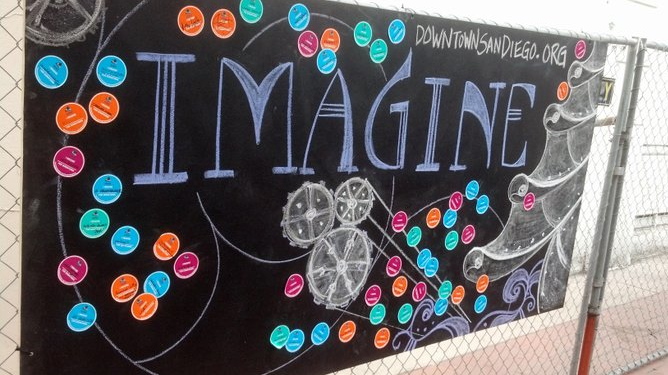 Facebook
Facebook
 X
X
 Instagram
Instagram
 TikTok
TikTok
 Youtube
Youtube

The Downtown San Diego Partnership took over a block of C Street this afternoon, October 24, astroturfing the sidewalks and inviting passersby in for an event the group billed "tactical urbanism."
A band performed at one corner, while the southern side of C between Third and Fourth avenues was lined with tables offering seating for 100 or more to stop in and eat lunch alongside the trolley tracks. Across the street, several works of art offered a view of what the block — fronted on one side by the U.S. Grant Hotel and on the other by abandoned buildings — could look like in an improved state.
"C Street is a vital civic corridor in Downtown that is blighted and underused. The Downtown San Diego Partnership has identified revitalizing C Street as a priority in its newly unveiled 20-year vision for Downtown San Diego," says a release promoting the activities. "This event is the first in a series to use the tenets of tactical urbanism to creatively reimagine important public spaces throughout Downtown."
The event, scheduled to run from 11:30 a.m. to 1 p.m., was initially sparsely attended, but more people began to trickle in as lunch hour arrived.
Along a fence, boards were placed with an invitation for everyone to jot down their vision for improving the block or downtown; colorful round stickers soon dotted the boards. Suggestions ranged from nonsensical (mustache wax) to the far-fetched (an "underground transit mall" and a red-light district) to the more predictable.
Several participants called for a new Chargers stadium downtown; about as many were asking for more public art, increased public-transit options, and bike-lane expansions. A significant number of stickers asked for a public pool to be installed nearby.
By far, the most popular suggestions, based on volume, were calls for more parks and green space (one suggested public rooftop gardens) and to address the homeless population problem.
Though no steps were identified as a means to address most of the concerns brought forth by the community, the Downtown Partnership earlier this year created a well-paid position specifically to conduct homeless outreach, so the organization and community at least appear to agree on the importance of that issue.


The Downtown San Diego Partnership took over a block of C Street this afternoon, October 24, astroturfing the sidewalks and inviting passersby in for an event the group billed "tactical urbanism."
A band performed at one corner, while the southern side of C between Third and Fourth avenues was lined with tables offering seating for 100 or more to stop in and eat lunch alongside the trolley tracks. Across the street, several works of art offered a view of what the block — fronted on one side by the U.S. Grant Hotel and on the other by abandoned buildings — could look like in an improved state.
"C Street is a vital civic corridor in Downtown that is blighted and underused. The Downtown San Diego Partnership has identified revitalizing C Street as a priority in its newly unveiled 20-year vision for Downtown San Diego," says a release promoting the activities. "This event is the first in a series to use the tenets of tactical urbanism to creatively reimagine important public spaces throughout Downtown."
The event, scheduled to run from 11:30 a.m. to 1 p.m., was initially sparsely attended, but more people began to trickle in as lunch hour arrived.
Along a fence, boards were placed with an invitation for everyone to jot down their vision for improving the block or downtown; colorful round stickers soon dotted the boards. Suggestions ranged from nonsensical (mustache wax) to the far-fetched (an "underground transit mall" and a red-light district) to the more predictable.
Several participants called for a new Chargers stadium downtown; about as many were asking for more public art, increased public-transit options, and bike-lane expansions. A significant number of stickers asked for a public pool to be installed nearby.
By far, the most popular suggestions, based on volume, were calls for more parks and green space (one suggested public rooftop gardens) and to address the homeless population problem.
Though no steps were identified as a means to address most of the concerns brought forth by the community, the Downtown Partnership earlier this year created a well-paid position specifically to conduct homeless outreach, so the organization and community at least appear to agree on the importance of that issue.
Comments